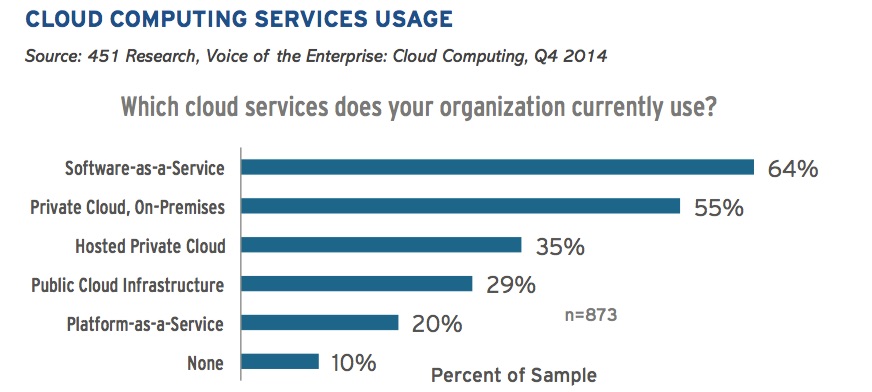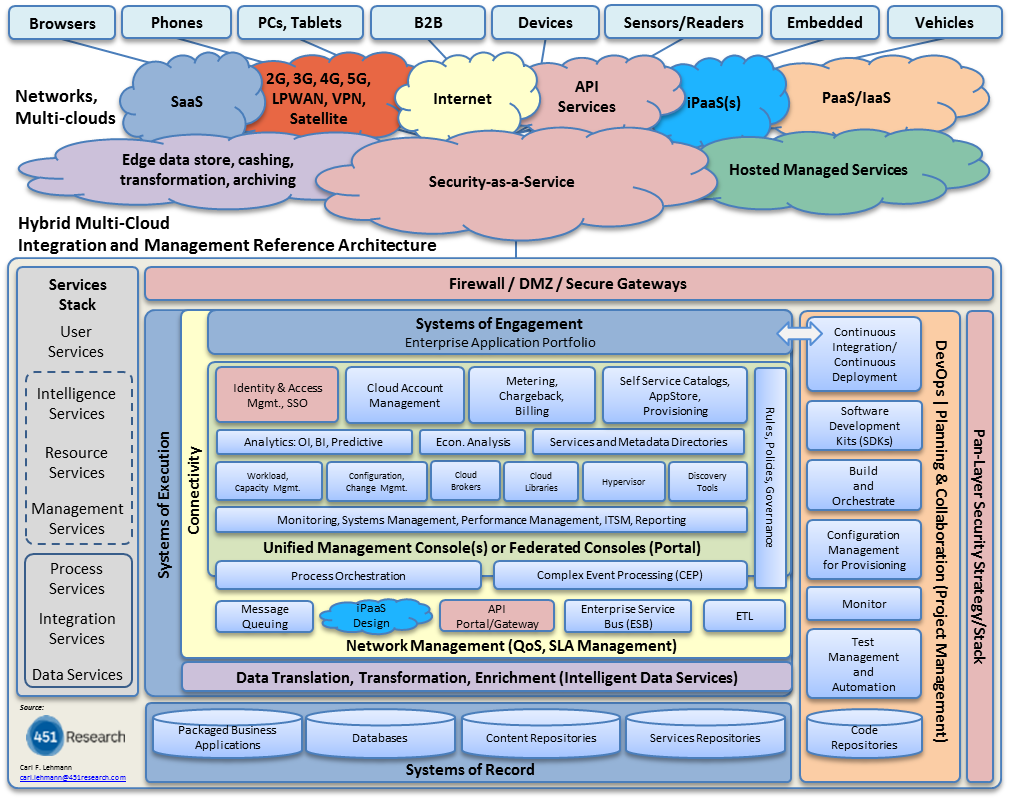For many enterprises, “the cloud” is an increasingly inaccurate term. Fully 70 percent of organizations are using a multitude of cloud services—and 37 percent of organizations have adopted hybrid cloud technology, based on new findings from 451 Research, which lets these disparate cloud services interact with one another.

Why is a multi-cloud approach gaining such popularity? To find the answer, we need first to look back at a bit of recent tech history.
Born from necessity, now embraced by IT
The cloud was born, not from IT necessity, but from the needs of business. Various lines of business (LOBs) needed specific types of support that IT couldn’t give them, primarily because the IT budget was entirely locked up in running day-to-day operations.
In those early days, those types of support included sales force automation, CRM, human resources, marketing automation, and supply chain management services. LOBs needed to enable or improve the automation of these operations to stay competitive in changing times. Many LOBs used their own budgets to take control of the matter. They turned to software-as-a-service (SaaS) providers to get the support they needed and integration platform-as-a-services (iPaaS) providers to link SaaS offerings with on-premises data sources. This pattern of ad hoc outsourcing accelerated, sometimes without enterprise IT's knowledge. LOBs were the first to drive the business into a multi-cloud environment.
IT organizations also inadvertently created the climate for multi-cloud infrastructure. They began spinning up compute and storage services from infrastructure-as-a-service (IaaS) providers and explored PaaS offerings from early public cloud services as a means to accelerate software development and testing. These tactics are still popular today. It was simply easier and faster to provision services online rather than spin up a development environment in the corporate data center. None of this was part of a grand cloud strategy. It was simply a reality, driven by need and basic economics.
Breaking out of old thinking
Roughly two to three years ago, IT managers finally started to wise up to what was happening in their organizations. The proliferation of cloud services was getting out of control. At last, IT felt that it had to do something to rein in the cloud bloat—particularly given the headline-making news at the time regarding the risk of data loss through third parties. Thus, policy-based cloud strategies were born.
Organizations began enacting policies that determined the circumstances under which certain workloads (applications, databases, repositories, etc.) would be deployed on certain execution venues (e.g., on-premises, private cloud, public clouds). Most policies were based on the value or risk associated with each workload. High-value/high-risk workloads might be required to run in the data center or on a private cloud service, while generic business processes could remain on an SaaS or public cloud service. IT began looking closely at the price/performance of various cloud services to determine the best execution venue for each workload. Inevitably, multi-cloud configurations occurred as each workload was migrated to its best execution venue or moved when the price was right.
In a nutshell, organizations have never said, “We need to adopt a multi-cloud architecture.” Rather, in most cases, multi-cloud approaches just happened, the result of pioneering LOBs and a few IT renegades.
And—surprise!—that has actually been a good thing, as it forced enterprises to break out of the inertia that developed from simply making sure that IT infrastructure was up and running, day after day. With LOBs stepping up to the plate and acting in their own interests, the IT organization has been forced to react, to understand the value proposition of various cloud infrastructures, and to be smart about where to invest the organization's resources. Multi-cloud as a formal strategy is a new and sudden idea, but most companies have gotten their arms around it surprisingly quickly.
Enter the hybrid cloud
Today, a preferred architecture has evolved in most organizations that looks primarily like this: On-premises servers, storage, and networks are maintained for high-value/high-risk workloads (such as financial data and intellectual property), and common business processes (such as CRM, marketing, and human resources) are migrated to various SaaS services. IaaS is adopted for rapid provisioning of compute, storage, and network resources, and PaaS is used for rapid application development and testing before apps are moved to their best execution venue.
By and large, these cloud services operate independently of one another; however, many enterprises are beginning to craft hybrid cloud systems that allow process orchestration across various execution venues. By enabling workloads to interoperate across heterogeneous cloud environments, organizational and data silos can be pushed closer together such that they could, perhaps, even converge.
Hybrid cloud management tools are the key to making sure nothing goes awry during this transition, which can be complex. While many cloud management tools are being integrated into existing cloud services as an added feature, cross-platform cloud management tools have been somewhat slower to emerge.
The diagram below shows some of the complexity involved in managing a true hybrid cloud environment.
Best practices for adopting a hybrid cloud environment
Migrating to and managing a hybrid cloud environment requires that a number of working parts operate smoothly together. While best practices are still emerging, here is some key advice from experts in the field:
- Be mindful of the transit of sensitive data. “A hybrid cloud approach can be beneficial, but it can also introduce complications that many enterprises may not be prepared for and may not have the capability to deal with,” says Alex Pezold, CEO of TokenEx. “Understanding where sensitive data exists is critical to determining what data can be moved to the cloud. Also, having clear knowledge of why each piece of data is being collected, how the data flows internally, and being able to categorize risk associated with sensitive data is crucial."
- Load balancing becomes a key issue in a hybrid environment. Michael Williams, eSignLive evangelism and community manager, reminds us that asymmetrical performance on different cloud services will result in bottlenecks. “Take care to make sure you have good load balancing to keep your system running smoothly,” he says.
- Compliance requirements may complicate your infrastructure. “Don’t assume compliance covers all security risks,” says Ben Desjardins, director of security solution marketing at Radware. “Some organizations will simply look at the security requirements within their industry to decide what level of dedicated cloud resources are requirements to maintain compliance. While this will keep you compliant, it will not, in most cases, factor in availability risks that can be a factor in multi-tenant environments. If, for example, you are sharing network resources, your assets could be at risk if another tenant within the environment is targeted with a DDoS attack.” You may, for example, need to separate storage from other aspects of your infrastructure in order to mitigate the risk of downtime.
- The “undo” button is a tricky one. Dean Mannella, co-founder of CTO Boost, reminds us, “Read the fine print. Once you’ve invested in the cloud, the cost of repatriating your data can be significant.” Mannella says you’ll likely spend five to seven times the cost of moving data to the cloud if you decide later to move it back in-house.
Hybrid cloud environments are as inevitable as the rise of the multi-cloud environments that preceded them. Note that a well-crafted, policy-based cloud strategy will help ease any growing pains. Remember that hybrid cloud environments can be rolled out slowly by spinning up one service or one LOB at a time. Take your implementation of hybrid cloud step by step, including whatever cloud interoperability pilot programs make sense, to enjoy the benefits of hybrid cross-cloud orchestration in your always evolving multi-cloud IT architecture.
Keep learning
Choose the right ESM tool for your needs. Get up to speed with the our Buyer's Guide to Enterprise Service Management Tools
What will the next generation of enterprise service management tools look like? TechBeacon's Guide to Optimizing Enterprise Service Management offers the insights.
Discover more about IT Operations Monitoring with TechBeacon's Guide.
What's the best way to get your robotic process automation project off the ground? Find out how to choose the right tools—and the right project.
Ready to advance up the IT career ladder? TechBeacon's Careers Topic Center provides expert advice you need to prepare for your next move.



